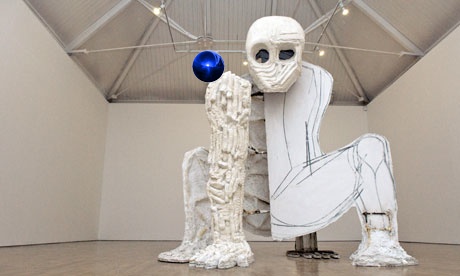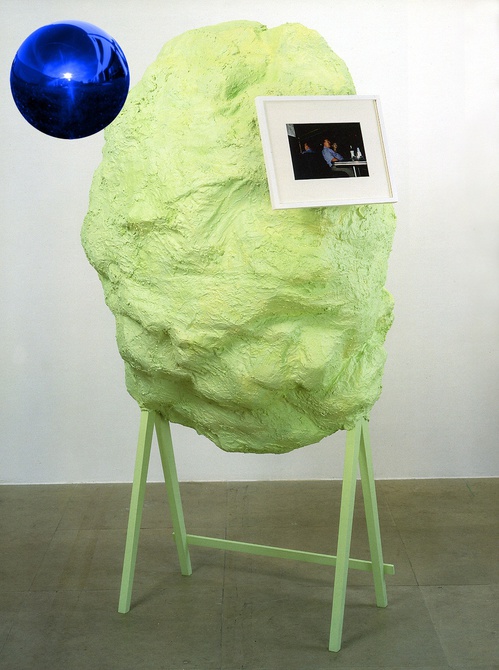
Satellite Communication: Untitled (YOUR NAME HERE), Study for Dasha
Previously: If I Were A Sculptor, But Then Again
Category: projects
Hong Kong Police Street View

Police in Hong Kong have deployed a new mobile pepper spray platform against protestors near Mong Kok.
I start with this image via @krislc, Kris Cheng, because it gives nice context, also the guy is watermarking it with his face? I’m filing that trick away for future use.
At first it looked like it’s made out of PVC pipe, but it’s surely painted steel. Actually, it looks like a smaller variation of the stairs in Home Depot.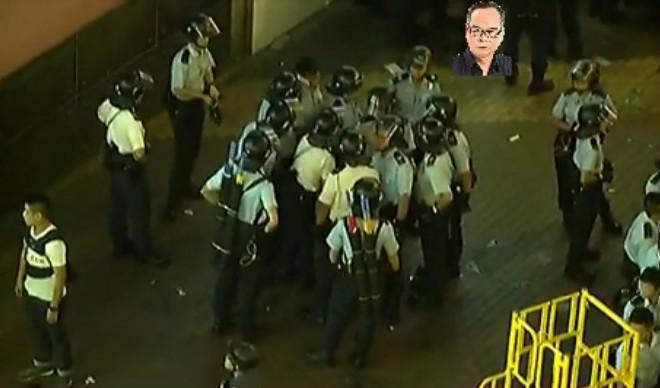
Most of the info comes from @galileo44, Galileo Cheng. Like this picture of the police conferring on Portland St. With their pepper spray cannons on their backs. Unless those are #umbrellas.
Here is krislcc’s Vine of the new platforms in use on her. Galileo calls them castles. They’re hand pumped. Like Super Soakers or something. Incredible.
Here’s another. What is most striking to me about this one is how the two police officers move together: one with the pepper spray, the other with a video camera. Kris Cheng says the the pepper spray isn’t that strong; the effects didn’t last more than 45 minutes. But the police will play a long game with those images.
Speaking of long game, holy smokes. I thought I’d scout out the Mong Kok streetscape on Google Maps, and this is what came up:
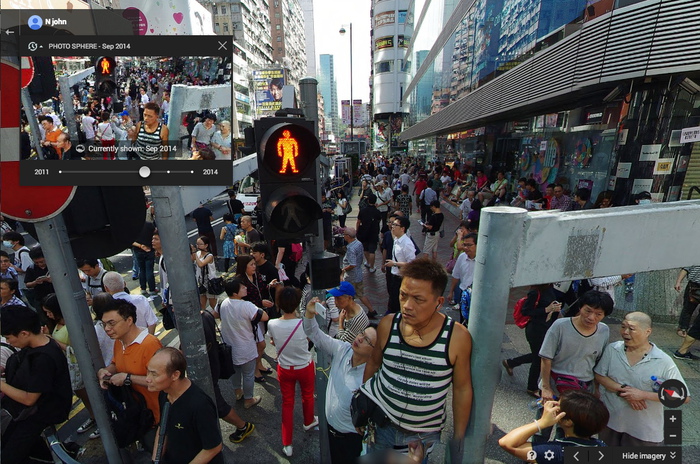
It was startling to be met by an unblurred face. And the vantage point was so high. But turn around. This is a pano. Or a “Photo Sphere.” From September, of the intersection blocked by a sit-in. It’s credited to nJohn.
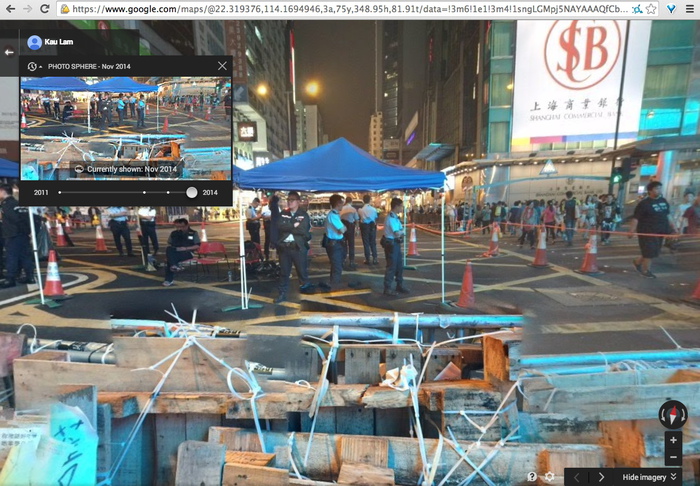
There are more recent Photo Spheres, too. Including November, by Kau Lam. The protestor-decorated police barricades are stitched together pano-style. Google Maps as a reporting platform. When will it go live? Will Google get castles of its own, or will cameras on long sticks suffice?
Better Read: Sincerely Yours, An Epic Scholarly Smackdown By Rosalind Krauss
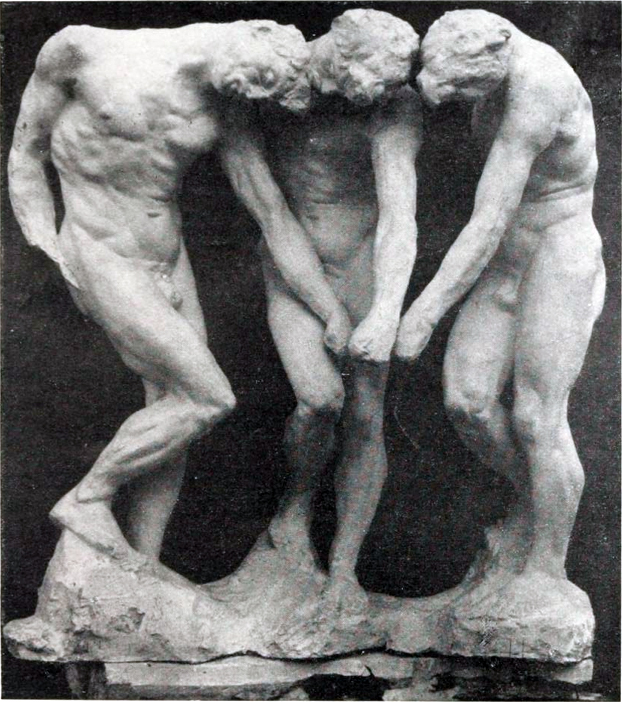
Auguste Rodin, The Three Shades, plaster, for The Gates of Hell
This edition of Better Read, an experiment in transforming art-related texts into audio works, is awesome. I really feel like the kinks are working out, and this whole computer voice-generated pseudo-podcast thing is really going to take off in a big way very soon.
Like an hour from now, when you’ve finished listening to “Sincerely Yours,” by powerhouse art historian Rosalind Krauss. In 1981 Krauss published one of her foundational texts, “The Originality of The Avant-Garde,” in October Magazine, which prompted a long, irate response from Rodin scholar and curator Albert Elsen. “Sincerely Yours” is Krauss’s fierce, icy, and vigorously argued, 9,200-word response to Elsen’s criticisms. It was originally published in October 20, in the spring of 1982. And it is performed here by Ava, an American English synthetic voice from Apple with a surprisingly good grasp of French pronunciation. The 80mb mp3 file lasts around 56 minutes. Like I said, this is going to be big, I can feel it.
Sincerely Yours, Rosalind Krauss (1982), read by a computer [dropbox greg.org, mp3, 80mb, 56:00]
Previously: Better Read: A Lively Interview with Ray Johnson c. 1968
The ur-text: W.H. Auden’s poem “The Shield of Achilles” read by a machine
Podcast: Play in new window | Download
Subscribe: RSS
Part Of A Scripture Writing
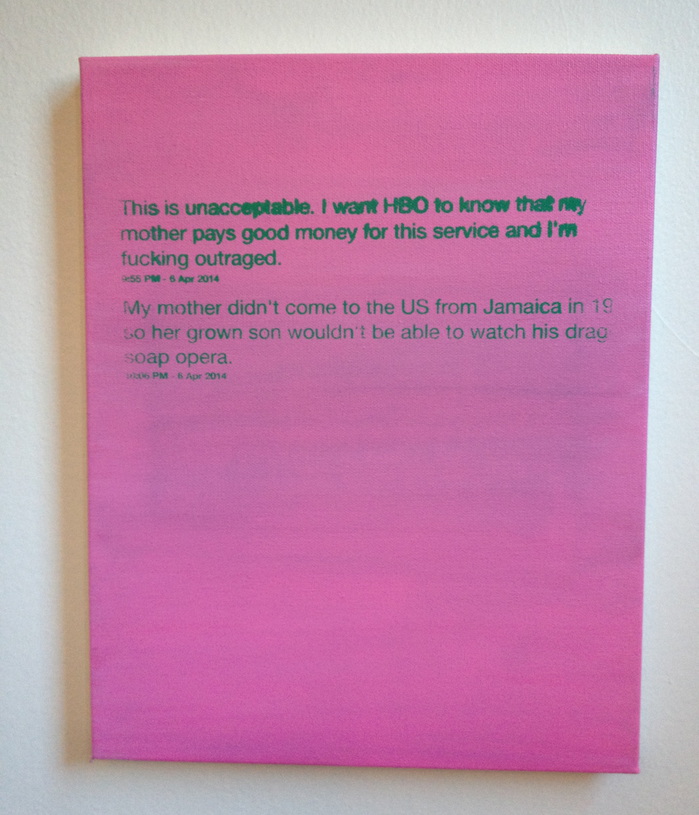
Although these paintings initially seem straightforwardly banal, at second glance their neutrality becomes more difficult to decipher. The viewer laughs but then perhaps questions how he reacted. The underlying tension to each of these tweets seems awkwardly dated to 2014 middle class America. @TheRealHennessy Tweet Paintings‘ tweets explore forces of sexual identity, and social acceptance revealing a dark underside. Many of the other tweets in the series leave the viewer in similar states of disbelief. greg.org deconstructs and examines the authenticity of the author, masculinity and his own identity. He is concerned with our fascination, fetishization, and acceptance of the image of social media. Chameleon-like, he changes from a consumer to a writer, and now artist.
Artists were casting sculptures in bronze, making huge paintings, talking about prices and clothes and cars and spending vast amounts of money. So I silkscreened jokes on little canvases and sold them for $1800 each. I have never thought making anything new. I make it again. I am very much against trying to make anything new in a modernist approach. I think you can do only something for yourself.
The true meaning of the @TheRealHennessy Tweet Paintings is still a matter of discussion. From a distance, they could even be read as abstract works. But viewed closely, their formal simplicity and their repetition seem to set them in the tradition of conceptualism. All in all, greg.org’s works are loaded with references to Structuralism and Post-modernist theories. Repetition deprives the tweet of its humour thus reducing it to a mere text in which the signifier takes over on the signified. After this, what is left?
Jenny Holzer’s Top Secret Papers
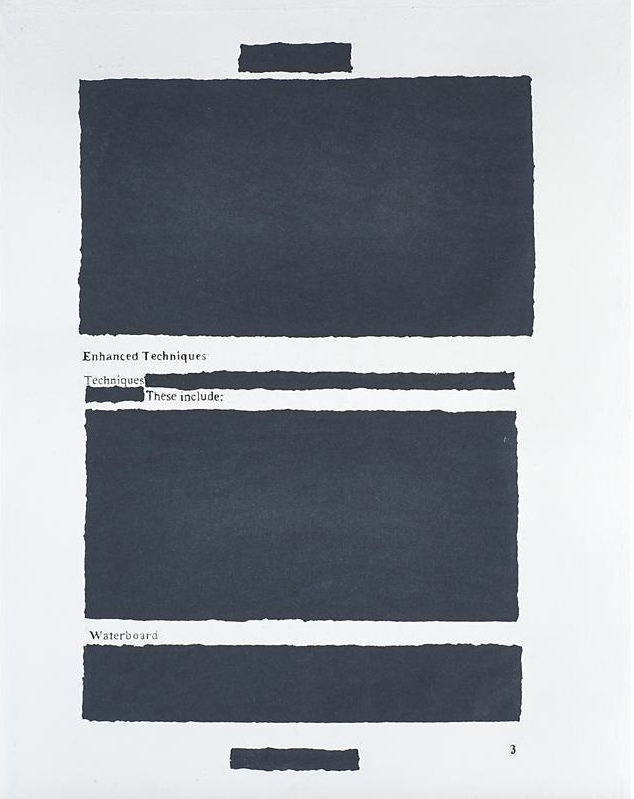
After seeing these epic FOIA monochromes from the Dept. of Homeland Security a few years ago, I’ve been collecting the best examples of redacted documents. I’ve never quite figured out what to do with them. Maybe a book.
I know Jenny Holzer’s been working on it for a while now. But I found her first batch of giant silkscreen on linen Redaction Paintings a little too slick. The Dust Paintings and Constructivist-inspired redaction paintings she showed this fall, though, are pretty great. Score one for the hand.
But then I just noticed this rather incredible, mysterious, and seemingly modest object in an upcoming Rago Arts auction. It’s a large (35×27 in) work titled Enhanced Techniques 3, and it’s described as a signed sheet of handmade paper. So the redaction is molded right in! I think Holzer has a winner here. But what? Where? And why is this thing only estimated to sell for $1000-1500?

A search for Holzer and handmade paper turn up other, similar pieces in the flotsam-filled auction reporting sites and secondary market print dealers. Try as they might, MutualArt couldn’t hide the fact that Rago had sold a handmade paper piece called Top Secret 24 last Spring. Rago certainly doesn’t want to hide it. I’d never thought of redaction in the same context of watermarking before.
On Caviar20 Top Secret 24 is pitched as Holzer’s “return to painting.” Hmm. At least they finally have pictures showing where this damn thing comes from. It’s ironic that people selling artworks about redaction leave out so much basic information.

griffelkunst director Dirk Dobke sitting in front of Jenny Holzer’s Top Secret portfolio. image: abendblatt.de
Anyway, the answer is griffelkunst, a 90-year-old print association in Hamburg with 4,500 subscribers and a closed 5-year-waitlist. Members pay €132/year for four contemporary artworks, which the association, currently led by curator Dirk Dobke, commissions and produces.
I don’t quite understand how that maps to Holzer’s Top Secret project, which was a suite of six handmade paper redaction editions, available to members only for €150 apiece, or €900 for the set. I guess they made as many as people ordered?
The labor-intensive process sounds like it syncs nicely with the subject: the white pulp on the redacted areas was scooped out by hand and filled in with black as each sheet was being made. And all of this sounds like fascinating context and backstory for the work. But no one’s using it to sell these things; just the opposite, they’re keeping it quiet. Whether it’s because griffelkunst frowns on flipping, or because it’s hard to explain a 10-20x markup, I can’t say.
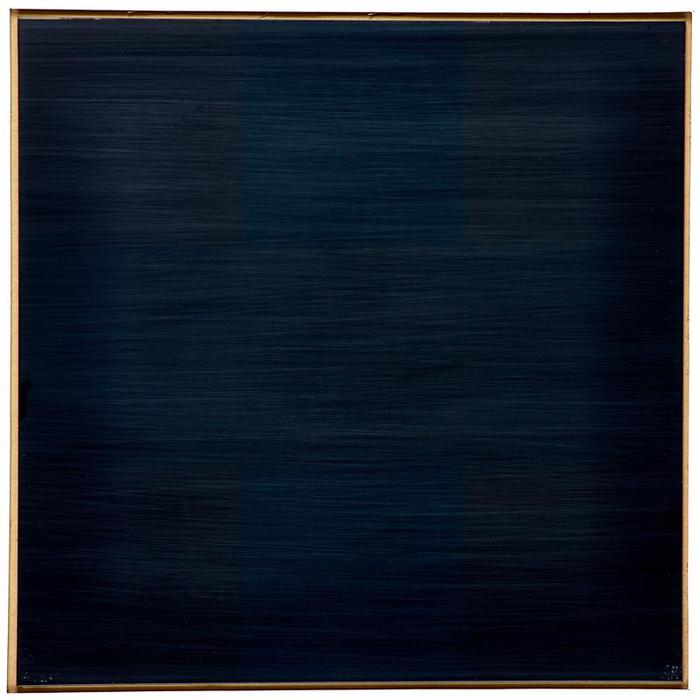
Holding back information is power, and the occlusion of information comes as no surprise. Strategic vagueness and decontextualization is as likely an art-selling technique as transparency and information overload. That same Rago auction also has an atypical-looking Ad Reinhardt. Well, it might look typical, but the small black monochrome square is actually an edition, silkscreened on plexiglass. It was “from NY International, 1966,” which turns out to be the title of a 10-artist Tanglewood Press print/multiples portfolio organized by Henry Geldzahler. Portfolios like these get broken up, and the slightly more marketable pieces parted out, all the time. But so many dealers and auctioneers redact the reason and context for which the artist created the work as part of their enhanced sales techniques.
@TheRealHennessy Tweet Paintings, Cont’d.
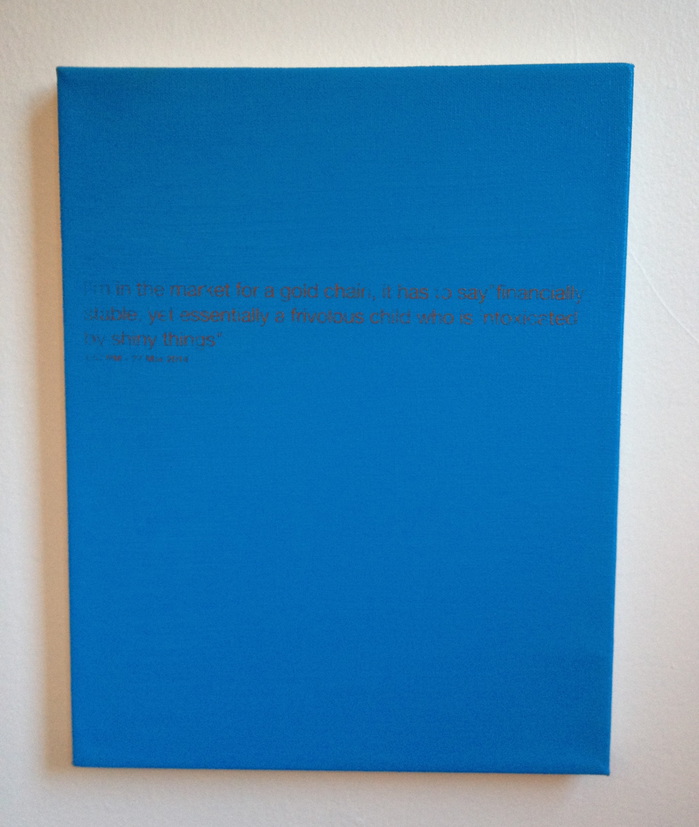
@TheRealHennessy Tweet Painting, Gold Chain, 2014, 14×11 in., acrylic and screenprint on canvas
Just in time for the Fall auctions, greg.org is pleased to present more @TheRealHennessy Tweet paintings, inspired by Donelle Woolford’s Dick Joke series which debuted at John McWhinnie in the 1990s, and which continue to be a source of brouhaha since Michelle Grabner’s 2014 Whitney Biennial.
The present work is one of greg.org’s @TheRealHennessy Tweet paintings, which rank among the contemporary era’s most iconic series by one of the most celebrated artists. Dryly presented with a deadpan sensibility, they consist of visual expressions of humor that are disarmingly immediate and resonant, yet abstract in their presentation. Describing his selections of form and content in his initial tweet paintings, greg.org later stated, “Within about six months I…started to do the tweets in ‘colors.’ I thought the color would be a substitution for an image. The background would be one color and the tweet would be another. I picked tweets that were ‘meaningful’ to me. I don’t know how to explain that except that the tweets’ ‘content’ was something that I could identify with. These ‘tweets’ were later identified as the ‘@TheRealHennessy Tweet paintings.’ I fell into them. I was walking around in a dark room looking for the light switch. I was moving by wading more than swimming. I was mowing the lawn. No direction home. I was caught in a landslide. My headaches were gone. I started painting with my fly open. I stopped crying. I started to laugh. Rock bottom sometimes isn’t the bottom. Barnett Newman, Willem de Kooning, Clyfford Still–look out.”
Continue reading “@TheRealHennessy Tweet Paintings, Cont’d.”
Glitch Gallery Installation Shots
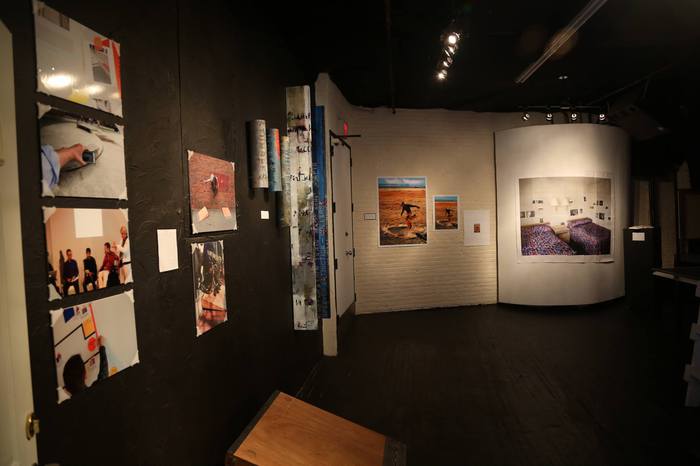
Installation shots from one of two shows currently on, this one titled “Challenging the law without Infringing the law,” curated by Primavera di Filippi, is at Glitch Gallery in Charlestown, MA for another couple of weeks. Those are Brian Dupont’s text paintings front and center there, with some Untitled (300×404) print versions to the right. They’re slightly different from the 20×200 edition, both in dimensions and medium, but like those editions, they look best when shown in multiple sizes.
There are more images atGlitch’s FB page.
Previously: 9/20: Opening in Charlestown
Better Read: A Lively Interview With Ray Johnson, c.1968
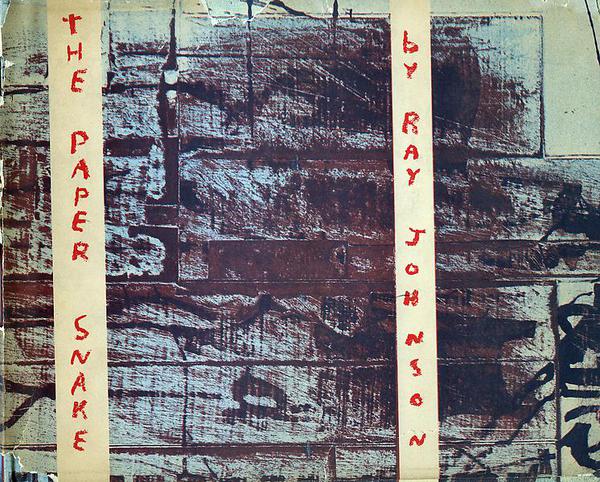
Ray Johnson, The Paper Snake, 1965, published by Dick Higgins, image: rayjohnsonestate
I’ve been thinking of various audio projects, something this side of an actual podcast, perhaps. But unlike a podcast, it’d be useful and interesting and not something being done already by everyone else.
And so I’m experimenting with a series I’m calling Better Read, art-related texts transformed into audio. While I’m working, I’ll often use text-to-speech to listen to papers, interviews, essays, and other various longform writings. It’s imperfect, but also an improvement. In the car, we’ve been listening to Moby Dick | Big Read, in which each chapter is read by a different person. It generally works.
So for Better Read, I am envisioning a mix of live and computer readers. Sometimes I’ll get the author herself; other times, someone can read from a text they really like. I might read a few myself, but to be honest, I really don’t like listening to me. Maybe you do? We may find out!
That W.H. Auden poem I posted the other day may become Better Read #1, and once I figure out the frequency, &c., I’ll set up a dedicated URL
But for now, please enjoy this 1968 interview with Ray Johnson, recorded for the Archives of American Art’s Oral History project. It really is a standout among an invaluable collection. And I especially like the idea of using a transcription of a recording as a script for another recording; fine tuning this process will be useful before I tackle any large, intense deposition transcripts [*cough* Canal Zone/Yes Rasta]
So definitely let me know your thoughts, advice, feedback, suggestions, requests, &c., and we’ll see how this thing shapes up.
Better Read: An Interview with Ray Johnson [45min, 22mb, dropbox greg.org]
Podcast: Play in new window | Download
Subscribe: RSS
Untitled (Tanya), 2014
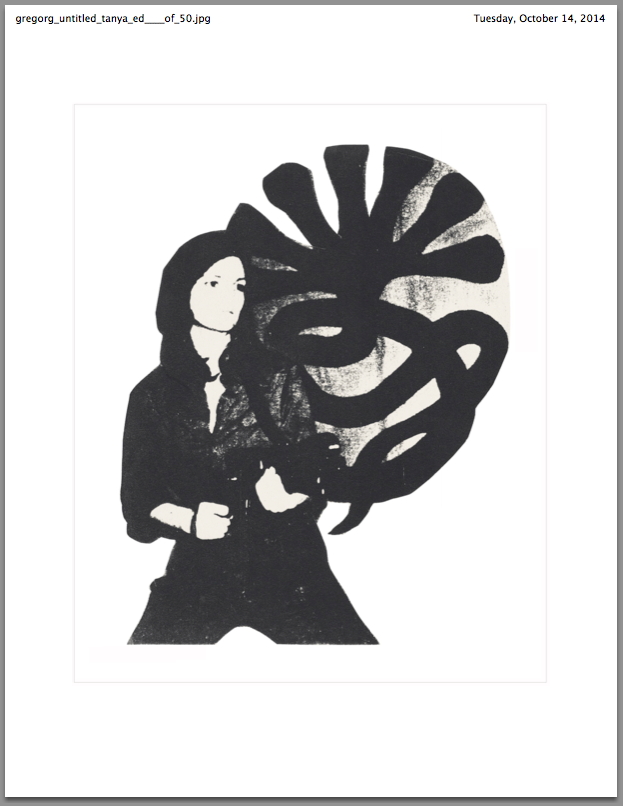
Study for Untitled (Tanya), 2014, lasercopy and graphite on white paper, 11×8.5 in., ed. 50
In honor of Frieze London, and all the awesome sales going down this week, I have created a special edition.
Untitled (Tanya) is a drawing on black & white lasercopy printed on 11 x 8.5 in. paper. It is titled, dated, stamped, and numbered in an edition of 50. Untitled (Tanya) depicts at actual size Tanya, the photocopy work of Cady Noland, which is being sold at Christie’s contemporary day sale Thursday Friday morning. The graphite marks of this work reference the dimensions of that work (7 5/8 x 6 1/8 in.).
Untitled (Tanya) will be available only during Frieze London week for $US10 each, shipped. [Update: Wow, nice, thanks. Definitely get a couple if you like, but please leave some prints for others, too.]
[UPDATE UPDATE: Unless it sells out beforehand, Untitled (Tanya) will only be available up until Cady Noland’s Tanya sells at Christie’s in London, around 2:30 UTC. So don’t underbid on Cady’s and then come slinking around here looking for photocopied consolation when you lose. Cuz you won’t get any.]
10/17 update: the edition is no longer available for purchase. thanks though.
Thanks again, all the prints are on the way. Unless they are cut down, this is what they look like:
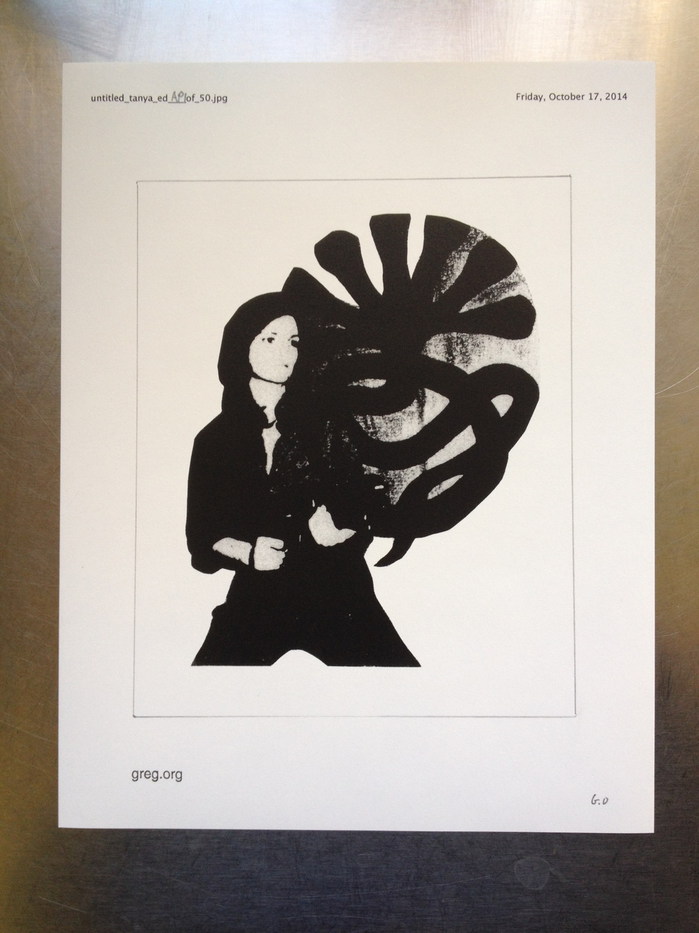
View Source: Richard Prince’s Instagram Portraits
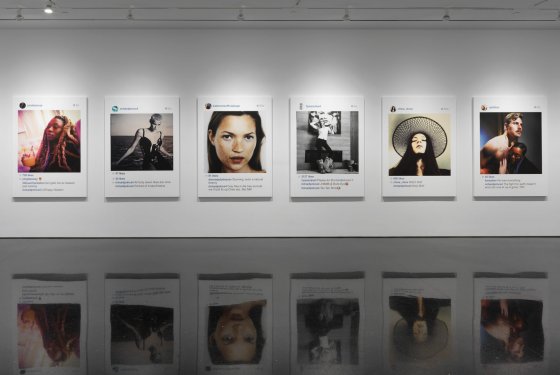
installation shot of Richard Prince, “New Portraits,” photo: Rob McKeever, via Gagosian 980 Madison
They’re getting more attention now because they’re on canvas and at Gagosian, but Richard Prince’s Instagram Portraits have been circulating for a while. Do we think of them differently than when he was assembling them in the spring and summer? When they were printouts on the floor instead of canvas on the wall? Or when they were $12 a sheet at karma in the Hamptons, or a couple hundred dollars a box at Fulton Ryder’s B-List book fair?
Continue reading “View Source: Richard Prince’s Instagram Portraits”
Untitled (Muji Tote), 2014
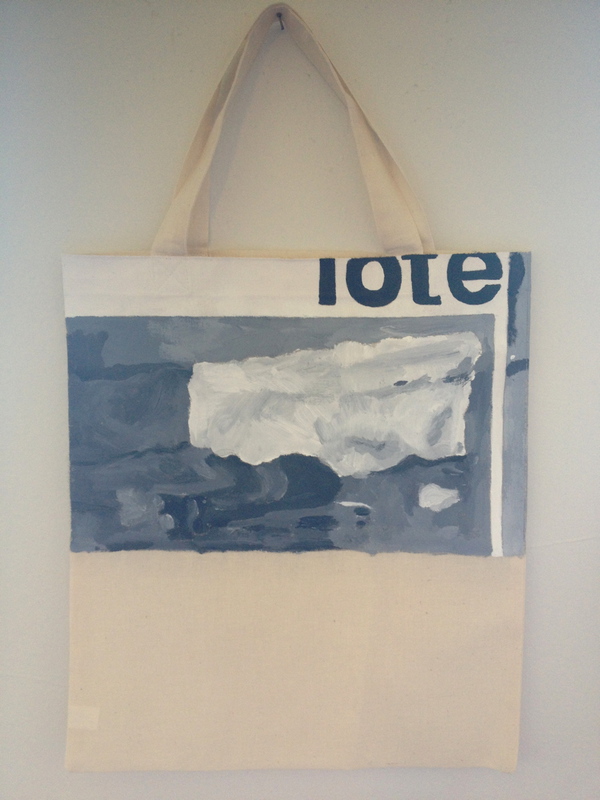
Untitled (Muji Tote), 2014, 19.5 x 12 x 1, acrylic on muslin
It’s been brewing for a long time, basically every time I see that painting it sticks to me like the smell of a campfire.
It really should be a product, a utility, an it bag for real men, no matter what part of Brooklyn they’re traversing.
But it never comes out right. No one will print right to the edge, and it really must be printed right to the edge. It could be screenprinted, but my queue’s pretty stacked right now. Printable heat-transfer paper frankly doesn’t do it justice.

image from The Internet
Wouldn’t you know, Kanye and Condo had the answer: just paint the damn thing. Which is a hard thing to accept sometimes. For some people. Who don’t, as a rule, paint. Anyway, here we are.
My favorite part of the whole thing now is that Muji Tote could translate into Anonymous Death. So even though there’s only one, and Kimye get first dibs on it [the 24hr clock starts ticking when I hit publish, get your 2nd holds ready], this really is for everyone.
Opening In Charlestown: Glitch Gallery
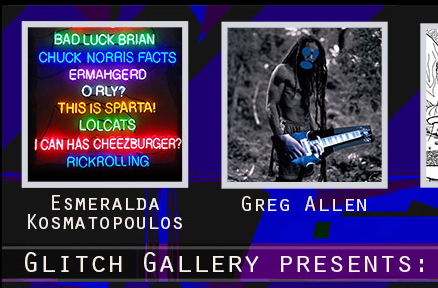
hello, new headshot
I wish I could be there right now, for the opening, but I’m stoked to announce the inclusion of some work in a group exhibition at Glitch Gallery in Charlestown, Massachusetts titled, “Challenging the law without infringing the law.” The show is curated by Primavera Di Filippi, and includes Brian Dupont, Sara Hendren, Esmerelda Kosmatopoulos, Kofhschlag, and Sara Newman & Matthew Battles.
The show is the first time that Untitled (300×404), a project I began in 2009, is being exhibited IRL. The work’s original is a 300x404px jpg image of a Richard Prince Cowboy photo, but the most widely known manifestation is the print edition published by 20×200.com. [Which is once again available, btw, in limited numbers.]
If you’re in or near Charlestown, I hope you’ll check out the show.
Glitch Gallery Exhibit 005 — Challenging the law without infringing the law, opens Sept 20, 2014 [glitchmonster.com]
Untitled (happy place), 2014

Untitled (happy place), 2014, 15.5×11 in., digital print on glossy stock, ed. 25+5AP, $100, shipped.
From Robert Smtihson & Mel Bochner’s “The Domain of The Great Bear” to Gerhard Richter and Ellsworth Kelly’s special editions of Die Welt, I’ve been interested print as art. A couple of years ago Printed Matter turned up a big stack of Inserts, a tabloid-sized portfolio of full-page artworks by the members of Group Material. The Public Art Fund helped the collective produce 90,000 copies, which were inserted in the Sunday New York Times on May 22, 1988, and distributed downtown and in Greenpoint/Bushwick. [even then.] A few turned up at Printed Matter a couple of years ago.
Group Material member Julie Ault recalled that they’d negotiated for nearly a year with the NY Daily News, but that when they submitted the artworks, they were rejected “on the basis that ‘it wasn’t art it was editorial.'” That tension or ambiguity is one of the things I like most; it upsets a seemingly small but persistent expectation.
I also love The Art Newspaper’s art fair editions, reported and published on the spot every day. And when I saw this page from this summer’s Art Basel paper, it seemed like an almost perfect object. It includes an excerpt from TAN editor-at-large Georgina Adams’ book, Big Bucks: The Explosion in the Art Market in the 21st Century which, like so much of the page, provides a salient, vital picture of the moment.
It’s taken me a little while to get it just right, but I am pleased to present Untitled (happy place) as a print in an edition of 25, with 5 artist proofs. It is digitally printed on gloss stock, handstamped and numbered, and measures 15.5 x 11 inches. It will ship flat for USD100.
Opening In Stamford: It Narratives At Franklin Street Works
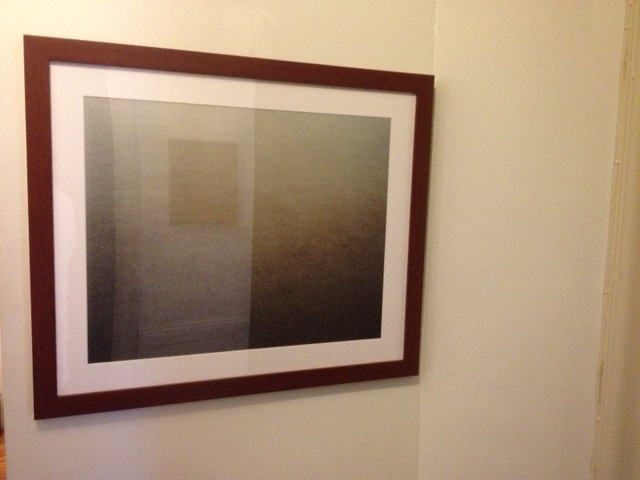
Shanzhai Gursky 002, 2014, not included in the show
Brian Droitcour and Zanna Gilbert have curated “It Narratives: The Movement of Objects as Information,” which just opened at Franklin Street Works in Stamford, Connecticut. The show examines shifting networks, and how artists use the postal system and the web in the production and distribution of artworks.
I am quite pleased to have some pieces included in the show, which runs through November 9.
In addition to some Destroyed Richter Paintings, the show includes a photo from the Shanzhai Gursky project, previously known in less ethnosocioeconomically critical times as Ghetto Gurskys. [Though the pejorative aspects of “ghetto” still apply to the project itself, in a self-critical way, I think the racialist connotations ultimately kill it for me. “Shanzhai” seems a little pluckier and resourceful than I’d originally pictured the series to be, but I really like it.]
The series are somewhat related, in that they both originate in images circulating online. The Destroyed Richter Paintings are made by Chinese Paint Mill and based on jpgs of photos Richter took in his studio before destroying certain paintings. The Shanzhai Gursky photos are produced to the specifications of the original using the highest resolution jpgs I could find in the wild.
In both cases, the web is the source of the image and the site of production for objects which are intended to be experienced in person. For this reason, and also because the show sounds very interesting, and is put together by sharp folks, I would encourage everyone to go see it.
It Narratives: The Movement of Objects as Information, runs from Sept. 5-Nov. 9, 2014, at Franklin Street Works [franklinstreetworks.org]
Previously, related: Ghetto [sic] Gursky
Unrolling Ghetto [sic] Gursky (Rhein) [which, archivists take note, is now titled Shanzhai Gursky 001.]

